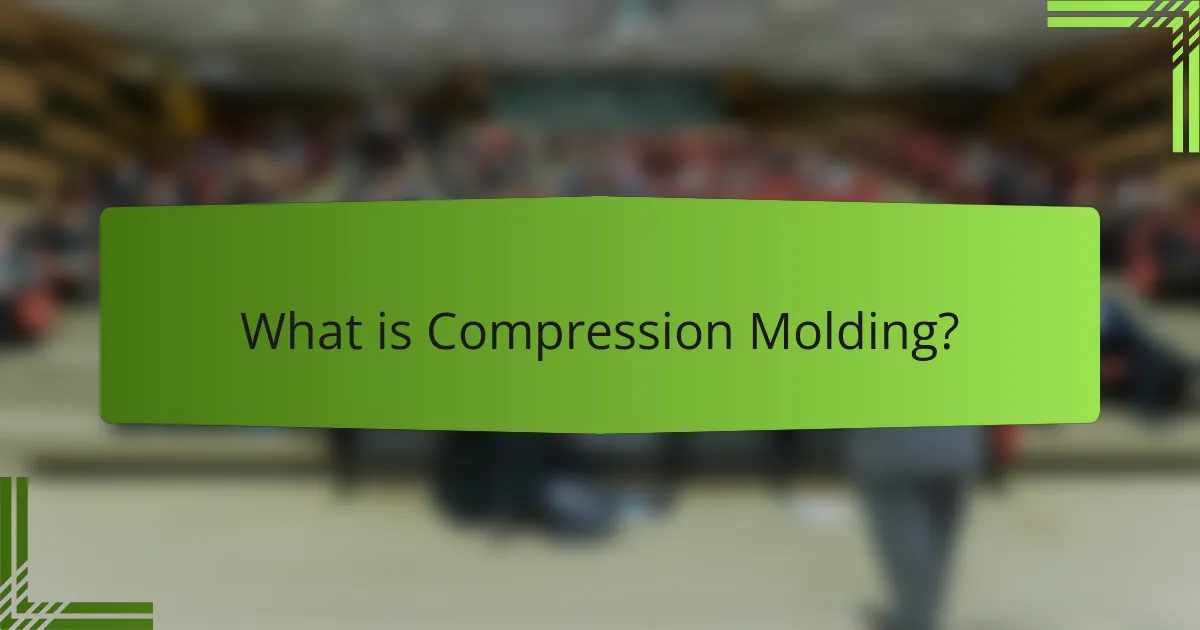Compression molding is a manufacturing process used to shape materials, particularly thermosetting plastics, by placing a pre-measured amount of material into a heated mold and applying pressure. This technique allows for the production of complex shapes with high accuracy and minimal material waste, making it efficient for high-volume production. Key techniques involved in compression molding include preheating the material, accurate placement within the mold cavity, and consistent pressure application, typically using a hydraulic press. The process finds applications across various industries, including automotive, aerospace, consumer goods, electrical, and medical sectors, highlighting its significance and anticipated growth in the global market.

What is Compression Molding?
Compression molding is a manufacturing process for shaping materials. It involves placing a pre-measured amount of material into a heated mold. The mold is then closed, applying pressure to form the material into the desired shape. This process is commonly used for thermosetting plastics. Compression molding allows for the production of complex shapes with high accuracy. It is efficient for high-volume production. The process also results in minimal waste of material. Compression molding has applications in automotive, aerospace, and consumer goods industries.
How does Compression Molding work in plastic production?
Compression molding is a manufacturing process used to shape plastic materials. It involves placing a pre-measured amount of thermosetting resin into a heated mold. The mold is then closed, and heat and pressure are applied. This process causes the resin to flow and fill the mold cavity. As the material cures, it hardens into the desired shape. Compression molding is efficient for producing large parts and is often used for automotive components and household items. The process allows for intricate designs and consistent quality in production.
What are the key stages involved in the Compression Molding process?
The key stages involved in the Compression Molding process are material preparation, mold loading, heating, compression, cooling, and part removal. Material preparation involves selecting and preheating the thermosetting or thermoplastic material. Mold loading requires placing the material into the heated mold cavity. Heating ensures the material reaches the required viscosity for flow. Compression involves applying pressure to shape the material within the mold. Cooling solidifies the material into its final form. Finally, part removal extracts the finished product from the mold, completing the process.
How do temperature and pressure influence Compression Molding?
Temperature and pressure significantly influence compression molding by affecting the material flow and curing process. Higher temperatures reduce the viscosity of thermosetting and thermoplastic materials. This allows for better flow into the mold, ensuring a more uniform distribution. Increased pressure during the molding process helps to compact the material, eliminating air pockets and enhancing the density of the final product.
The combination of elevated temperature and pressure can accelerate the curing time of thermosetting resins. This results in shorter cycle times and increased production efficiency. Studies show that optimal temperature ranges between 120°C to 180°C and pressure levels around 1000 to 3000 psi yield the best results in terms of part quality and consistency.
Inadequate temperature or pressure can lead to defects such as incomplete filling or weak bonding. Therefore, precise control of these parameters is crucial for achieving high-quality molded parts.
What are the primary materials used in Compression Molding?
The primary materials used in compression molding are thermosetting plastics and elastomers. Thermosetting plastics, such as epoxy and phenolic resins, undergo a chemical change when heated, becoming rigid and heat-resistant. Elastomers, like silicone and rubber, provide flexibility and resilience. These materials are selected for their ability to withstand high temperatures and pressures during the molding process. Compression molding is commonly used in industries like automotive and consumer goods, where durable components are required. The choice of material impacts the final product’s performance and application suitability.
What types of plastics are most commonly used in Compression Molding?
The most commonly used plastics in compression molding are thermosetting plastics. These include materials such as phenolic, epoxy, and melamine resins. Thermosetting plastics are favored for their durability and heat resistance. They undergo a chemical change during the curing process, which solidifies their structure. This characteristic makes them ideal for applications requiring high strength and thermal stability. Additionally, thermoplastic elastomers are also used in some compression molding processes. They provide flexibility and resilience, making them suitable for various applications. Overall, the choice of plastic depends on the specific requirements of the end product.
How do the properties of these materials affect the final product?
The properties of materials significantly influence the final product in compression molding. Material characteristics such as viscosity, thermal stability, and curing time determine how well the material flows and fills the mold. High viscosity materials may not fill intricate mold designs effectively, leading to incomplete products. Thermal stability affects the material’s ability to withstand processing temperatures without degrading.
Curing time impacts production efficiency; shorter curing times can speed up the overall manufacturing process. Additionally, the filler content alters mechanical properties like strength and flexibility. For example, adding glass fibers enhances tensile strength but may reduce impact resistance.
Understanding these properties is crucial for optimizing product quality and performance. The right material selection directly correlates with the durability and functionality of the final product.
What are the advantages of using Compression Molding?
Compression molding offers several advantages in plastic production. It allows for the efficient creation of complex shapes. The process can accommodate a wide variety of materials, including thermosets and elastomers. Compression molding typically requires less energy compared to other molding methods. It also minimizes waste, as excess material can be reused. The technique enables high production rates, making it suitable for large-scale manufacturing. Additionally, it provides excellent surface finishes and dimensional accuracy. These benefits are significant for industries requiring reliable and cost-effective production methods.
How does Compression Molding compare to other molding techniques?
Compression molding is a manufacturing process that involves shaping materials by applying heat and pressure. It differs from other molding techniques, such as injection molding and blow molding, in several key ways. Compression molding typically requires longer cycle times compared to injection molding, which is more efficient for high-volume production.
In compression molding, the material is placed in an open mold and then closed, while injection molding injects molten material directly into a closed mold. This results in compression molding being better suited for larger parts and complex shapes. Additionally, compression molding can handle a wider range of materials, including thermosets and elastomers, which may not be suitable for injection molding.
The process of compression molding also tends to produce less waste than other techniques, as it utilizes the entire material without excess trimming. Furthermore, the tooling costs for compression molding can be lower than those for injection molding, making it more cost-effective for small production runs.
What cost benefits does Compression Molding provide?
Compression molding provides significant cost benefits by reducing material waste and lowering production costs. This process utilizes only the necessary amount of material for each mold, minimizing excess. It also allows for the efficient use of lower-cost raw materials. Additionally, compression molding typically requires less energy than other molding processes, leading to lower operational costs. The equipment used for compression molding is often less expensive than injection molding machinery. Furthermore, shorter cycle times can increase production output, further enhancing cost efficiency. These factors collectively contribute to lower overall manufacturing expenses in plastic production.

What are the key techniques in Compression Molding?
The key techniques in compression molding include preheating, material placement, and pressure application. Preheating involves warming the material to enhance flow and reduce curing time. Material placement requires accurate positioning of the material in the mold cavity. Pressure application is critical for shaping the material and achieving desired thickness.
These techniques ensure uniform distribution of the material and optimal curing. The process typically involves using a hydraulic press to apply consistent pressure. This method is widely used for thermosetting plastics and rubber products.
According to industry reports, compression molding can produce complex shapes with minimal waste. The technique is efficient for high-volume production runs.
How do different techniques impact the quality of molded products?
Different techniques significantly impact the quality of molded products. Techniques such as compression molding, injection molding, and blow molding each produce distinct outcomes. Compression molding often results in products with superior surface finish and dimensional stability. Injection molding typically allows for more complex shapes and tighter tolerances. Blow molding is ideal for hollow products, ensuring uniform wall thickness. Each technique’s parameters, like temperature and pressure, directly affect material flow and cooling rates. These factors influence the final product’s strength, durability, and appearance. Studies show that optimizing these parameters can enhance product quality, as evidenced by improved mechanical properties in molded parts.
What is the role of preheating in Compression Molding?
Preheating in compression molding is essential for optimizing material flow and reducing cycle times. It helps to soften the thermosetting or thermoplastic materials before they enter the mold. This process enhances the material’s viscosity, allowing for better filling of the mold cavity. Preheating also minimizes the risk of defects caused by incomplete filling or cold spots. Studies have shown that preheating can significantly improve the mechanical properties of the final product. For instance, it can lead to better dimensional stability and surface finish. Overall, preheating plays a critical role in ensuring consistent quality in compression molding processes.
How does the choice of mold design affect the process?
The choice of mold design significantly affects the compression molding process. A well-designed mold ensures even material distribution and reduces defects. It influences the cooling rate, which impacts cycle time and part quality. The mold’s surface finish affects the final product’s texture and appearance. Additionally, complex designs may require more precise machining, increasing production costs. Studies show that optimized mold design can enhance production efficiency by up to 30%. Thus, selecting the appropriate mold design is crucial for achieving desired outcomes in plastic production.
What are the common challenges faced in Compression Molding?
Common challenges faced in compression molding include uneven material distribution, difficulty in achieving precise dimensions, and long cycle times. Uneven material distribution can lead to defects in the final product. Difficulty in achieving precise dimensions often results from variations in material flow. Long cycle times can reduce overall productivity in manufacturing processes. Additionally, maintaining consistent temperature and pressure is crucial for quality. Variations can cause issues like incomplete filling or warping. These challenges can significantly impact the efficiency and quality of the compression molding process.
What issues can arise during the material preparation phase?
Issues during the material preparation phase include inconsistent material quality, improper mixing ratios, and contamination. Inconsistent material quality can lead to defects in the final product. Improper mixing ratios may affect the material’s properties, such as strength and flexibility. Contamination from foreign substances can compromise the integrity of the materials. Additionally, inadequate drying of materials can result in moisture-related defects. These issues can ultimately impact production efficiency and product performance.
How can defects in molded products be minimized?
Defects in molded products can be minimized by optimizing the molding process parameters. Key parameters include temperature, pressure, and cooling time. Maintaining consistent temperature ensures uniform material flow and reduces warping. Proper pressure application prevents air entrapment and ensures complete mold filling. Adjusting cooling time can prevent internal stresses and dimensional inaccuracies. Additionally, using high-quality raw materials reduces the likelihood of defects. Regular maintenance of molds also prevents wear and tear, which can lead to defects. Implementing a quality control system can identify issues early in the production process, allowing for timely corrections.

What are the applications of Compression Molding in various industries?
Compression molding is widely used across various industries for producing parts with complex shapes. In the automotive industry, it creates components like dashboards and bumpers. The aerospace sector utilizes compression molding for lightweight structural components. Consumer goods often feature molded parts, such as containers and packaging. Electrical and electronics industries benefit from molded insulators and housings. Medical devices and equipment are also produced using this technique for precision and reliability. According to a report by MarketsandMarkets, the global compression molding market is expected to grow significantly, indicating its increasing relevance across these sectors.
Which industries primarily utilize Compression Molding techniques?
The industries that primarily utilize Compression Molding techniques include automotive, aerospace, consumer goods, and electronics. In the automotive industry, compression molding is used to produce parts like dashboards and bumpers. Aerospace applications include components such as interior panels and structural parts. Consumer goods often involve the creation of items like kitchenware and toys through this technique. Electronics manufacturers use compression molding for producing housings and insulators. These industries benefit from compression molding due to its efficiency in producing complex shapes and durable materials.
How is Compression Molding applied in the automotive industry?
Compression molding is applied in the automotive industry to produce various components. This manufacturing process involves placing raw material in a heated mold. The mold is then closed, and pressure is applied to shape the material. This technique is commonly used for creating parts like dashboards, door panels, and bumpers.
Compression molding offers several advantages in automotive applications. It allows for the production of large, complex shapes with high precision. The process also minimizes waste, as excess material can be reused. Additionally, it enables the use of reinforced materials, enhancing the strength of automotive components.
According to industry reports, compression molding is favored for its efficiency and cost-effectiveness in mass production. The automotive sector increasingly relies on this method for sustainable manufacturing practices.
What role does Compression Molding play in consumer goods production?
Compression molding is a manufacturing process used in consumer goods production. It involves placing a material, usually in a preheated state, into a mold cavity. The mold is then closed, and heat and pressure are applied to shape the material. This method is efficient for producing large quantities of items with consistent quality. It is commonly used for items like rubber seals, plastic components, and household goods. Compression molding allows for complex shapes and reduces waste material. Additionally, it can accommodate various materials, including thermosets and thermoplastics. This versatility makes it a vital technique in the consumer goods sector.
What future trends are emerging in Compression Molding?
Future trends in compression molding include advancements in materials, automation, and sustainability. The development of bio-based and recycled materials is gaining traction. These materials help reduce environmental impact and enhance product performance. Automation technologies are improving efficiency and precision in the compression molding process. This leads to reduced cycle times and lower labor costs. Additionally, smart manufacturing practices are being integrated into compression molding. These practices utilize data analytics and IoT for real-time monitoring and optimization. Industry 4.0 is influencing the adoption of these technologies. Overall, these trends are shaping the future of compression molding for enhanced productivity and sustainability.
How is technology enhancing Compression Molding processes?
Technology is enhancing Compression Molding processes through automation and advanced materials. Automation improves precision and reduces cycle times. Robotic systems handle material placement and component assembly efficiently. Advanced materials, such as thermoplastics, enable better flow and mold filling. Smart sensors monitor temperature and pressure in real-time. This data allows for immediate adjustments, ensuring optimal conditions. Additionally, simulation software predicts mold behavior before production. These innovations lead to higher quality products and reduced waste. Overall, technology streamlines Compression Molding, making it more efficient and cost-effective.
What innovations are shaping the future of materials used in Compression Molding?
Innovations shaping the future of materials used in compression molding include advanced thermosetting resins, bio-based composites, and enhanced fillers. Advanced thermosetting resins offer improved thermal stability and mechanical properties. Bio-based composites are gaining traction due to their sustainability and reduced environmental impact. Enhanced fillers, such as nanomaterials, increase strength and reduce weight in molded products. These innovations lead to more efficient manufacturing processes and better product performance. Research shows that the adoption of these materials can significantly enhance the durability and functionality of molded components.
What best practices should be followed in Compression Molding?
Best practices in compression molding include precise temperature control, appropriate material selection, and proper mold design. Maintaining the correct temperature ensures optimal material flow and prevents defects. Selecting the right materials enhances the final product’s performance and durability. Designing molds with adequate venting minimizes trapped air, reducing the risk of voids. Additionally, using consistent material loading techniques promotes uniformity in the molded parts. Regular maintenance of equipment prevents unexpected downtime and ensures consistent quality. Implementing thorough quality checks during production helps identify and rectify issues early. Following these practices leads to improved efficiency and product quality in compression molding operations.
Compression molding is a manufacturing process used to shape thermosetting plastics and elastomers by applying heat and pressure to a pre-measured amount of material in a heated mold. The article explores the key stages of the compression molding process, including material preparation, mold loading, and curing, while highlighting the influence of temperature and pressure on product quality. It also discusses the primary materials used, advantages of compression molding, and its applications across various industries such as automotive, aerospace, and consumer goods. Additionally, the article addresses common challenges, future trends, and best practices for optimizing the compression molding process.


